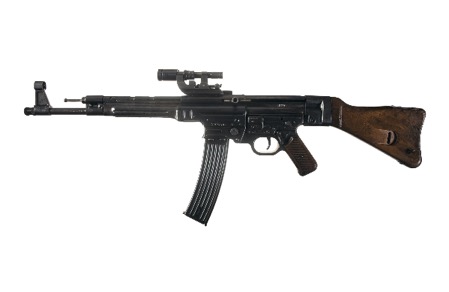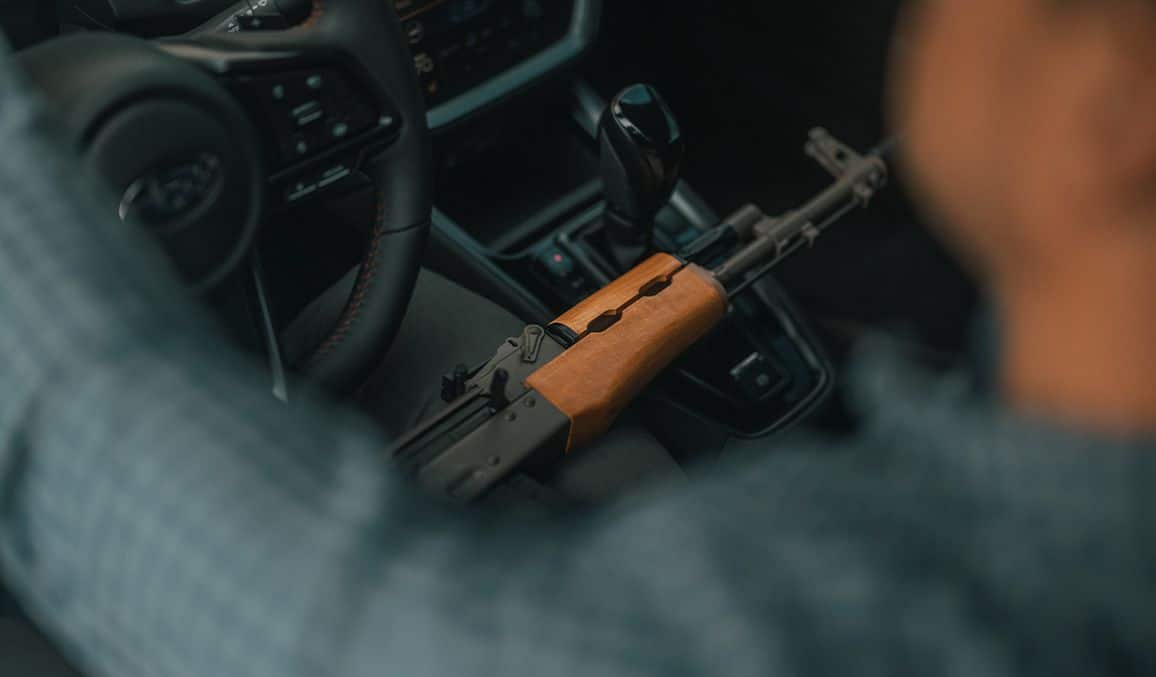Intermediate sized rifle cartridges have characterized the assault rifle concept adopted by most major countries in the latter half of the twentieth century and the beginning of the twenty first century. They provide the infantry soldier with the needed lethality and accuracy to engage adversaries at realistic combat ranges inside of 300 meters. In order to understand how these cartridges came into widespread use, it is important to take a look at how modern land warfare has evolved.
The Changing Nature of Warfare and Weapons
Hiram Maxim’s invention of the belt-fed machine gun in the late 19th Century began to alter the nature of infantry engagements and tactics. Their use in 1893 by the British in the First Matabele War in Southern Africa, and later by the Russians and Japanese in the Russo-Japanese War, showed the devastating effect that machine guns could have against large formations of foot soldiers. Unfortunately, the lessons learned from those wars were not fully appreciated and during World War I massive casualties continued to be inflicted by the deadly weapons. On the first day of the Battle of the Somme, almost 20,000 British troops were killed, many of them by the German Army’s version of the Maxim machine gun, the Maschinengewehr 08, or MG 08.
After World War I, the defeated Germans worked to rebuild their Army in clear violation of the Treaty of Versailles, which had been imposed upon them by the victorious Americans, British and French.
As Germany rebuilt its military forces, they took a hard look not only at the infantry tactics used in World War I but also how the rapid-firing weapons had caused enormous losses on both sides of the battlefield. They also looked at how crude and lightly armored tanks, used only in limited numbers in World War I, could be improved upon and utilized to shape the outcome of future wars.
Perhaps the most influential German strategist of the interwar period was Heinz Guderian. Guderian developed the concept of the blitzkrieg or “lighting attack” where motorized infantry, supported by armor, would pour into weak points of an enemy’s defensive line, breaking through and then enveloping the enemy from behind. The new strategy proved highly effective and was responsible for the success of the German Army in the early years of World War II. The new style of warfare avoided the heavy casualties of infantry confronting machine guns head-on and depended on maneuvering troops and vehicles to outflank them instead.
This new motorized warfare relied not just on traditional long rifles but also on machine guns and submachine guns to deliver suppressive fire on an enemy as the assault proceeded. As the war progressed, German arms engineers scaled down the large 7.92x57mm round used in their Kar98k bolt action rifles and created the 7.92x33mm Kurz cartridge:

Figure 1: 7.92x33mm Kurz cartridge was the basis for an entirely new class of infantry weapons. Source: Wikipedia
The rationale for this new intermediate sized case was to bridge the gap between short-range pistol caliber submachine guns and the larger, more powerful battle rifles used by Nazi Germany’s Wehrmacht. It allowed for lighter, more compact weapons that could fire like a machine gun when closing on enemy forces. It also allowed soldiers to engage targets at ranges greater than their 9mm subguns.
This new German intermediate-sized cartridge case was first used the Maschinenkarabiner 42(W) and Maschinenkarabiner 42(H) designed by the German firms of Walther (W) and Haenel (H) respectively. Elements from both weapons were fused into the MP43:

Figure 2: This early Haenel produced MP 43/1 (with rare scope attached) was the first production model of the assault rifle concept with later versions being called the MP44 and the Sturmgewehr 44 (StG44). Source: Rock Island Auction Company.
The MP43 was produced in small numbers during the middle of the war but as the weapon was refined and accepted by troops, the numbers increased. The final version, the Sturmgewehr 44 (StG44) was reliable (and deadly) and is considered by many observers as the first assault rifle (the English translation of Sturmgewehr) to see widespread use.
German arms designer Hugo Schmeisser played a critical role in the development of the MP43/MP44/StG44 series, particularly with respect to its use of sheet metal stampings. Following the war, Schmeisser and several other German weapon designers were forcibly resettled by the Russians to Izhevsk, the capital city of Udmurtia, and home to a major Russian small arms design and manufacturing facility. Many historians believe that they played a role in refining Mikhail Kalashnikov’s AK-47 design particularly in its early fabrication from stampings. Schmeisser was eventually allowed to return to Germany in 1952 but he died a year after being repatriated.
Russian Development of Intermediate-Sized Cartridges
While many ascribe the development of the Soviet 7.62x39mm cartridge to the AK-47, the reality is that the cartridge preceded the development of Kalashnikov’s famous rifle. The first variant, actually 41mm in length, was officially adopted for Russian service after successful testing in December 1943. The case length would eventually be shortened to 39mm. The resulting cartridge was matched to the equally innovative semiautomatic SKS carbine designed by Sergei Simonov to replace the 7.62x54mmR SVT-40, Russia’s primary semiautomatic rifle of World War II. SKS prototypes saw limited use towards the end of World War II but did not really enter full scale production until after the war. Although the SKS proved to be a successful design–and was adopted by China and many Warsaw Pact countries– it was eventually overshadowed by the AK-47/AKM rifles. The AK’s select fire capability and detachable 30 round magazine offered significant advantages over the semi-auto only SKS and its non-detachable 10 round magazine. Russia and others also produced the 7.62x39mm RPD belt fed machine gun for some time but that was also replaced by the Kalashnikov-inspired RPK. For a brief period of time, Czechoslovakia used their homegrown 7.62x45mm cartridge in own post-war weapons, but they soon replaced it with the Soviet round.
The 7.62x39mm Cartridge
Without a doubt, the purpose-built 7.62x39mm cartridge became the premier intermediate-sized assault rifle caliber of the twentieth century and it continues to dominate battlefields well into the twenty-first century. Its success is inexorably tied to that of the AK-47 and the AKM rifles whose production numbers make it the most prolific firearm in history. The quantities manufactured are likely in the 100 million range.
The cartridge is not particularly known for its accuracy in large part because the AK itself prioritized reliability and simplicity over precision. Acceptable accuracy for an AK rifle is usually considered to be 4 to 6 Minutes of Angle (MOA) which is perfectly adequate for man-sized targets out to its maximum range of approximately 300 yards/meters.
Weapons are typically designed as an integrated system consisting of the gun’s operating characteristics, feeding device and the caliber used. The AK-47 (and the later AKM) were designed around the 7.62x39mm cartridge and it very much compliments the AK’s dependability and ruggedness. A visual inspection of the cartridge case reveals why. The tapered design allows for easy feeding and extraction and the thick rim is unlikely to be torn by an extractor even when used in over-gassed firearms like the AK. The tapered design necessitates the use of the distinctive curved magazines in order to ensure proper feeding when fully loaded:

Figure 3: The tapered case of the 7.62x39mm cartridge and its thick rim contribute to the reliability of the AK rifle. Source: Wikipedia
Initially, most AK magazines were made of stamped sheet metal but later designs used Bakelite (the first plastic) or modern polymers in their construction, often with steel reinforcements. 30 round magazines are the most common but compact 20 round versions can also be found. 40 round mags, 60 round quad stack magazines and 75 round drum magazines have also been produced in various countries and of varying quality.
The 7.62x39mm has seen its bullet design and composition tweaked over the years. The original M43 round consisted of a 123 grain steel-cored, boat tail bullet with a thin copper or brass jacket. Its importation into the US—including from Russian or Chinese manufacturers– has been banned because of its steel composition. BATF considers it an armor piercing round. The Yugoslav designated M67 bullet designed in the 1960s did away with the steel penetrator and replaced it with soft lead. The M67 also flattened the bullet’s boat tail. While some attribute the M67’s core replacement with lead as a way to increase lethality, it was more likely a matter of raw material costs and availability. Today, most 7.62x39mm rounds in circulation utilize lead core bullets. Many soft tipped and hollow pointed hunting bullets have also been developed. The original M43 rounds, along with specialized subsonic and armor piercing designs, remain available for police and military use.
7.62x39mm cartridges can be found with both brass and steel cases. Modern cases are loaded with non-corrosive primers and powders but plenty of surplus corrosive ammo continues to be sold. Make sure you know what you are buying and clean your weapons accordingly. Corrosive ammunition requires flushing a weapon with hot water after firing in order to remove the damaging salts left behind. Special attention should be paid to the barrel, chamber, gas tube and piston.
Muzzle velocity for 123 grain 7.62x39mm ammunition is approximately 2350 fps from a 16” barrel. Muzzle energy will be in the 1500 ft-lb category. Sighted in at 100 yards, users can expect the bullet to drop approximately 7.2 inches at 200 yards and 26.6 inches at 300 yards. The cartridge will produce adequate terminal effects from a shorter barrel, with lower but respectable velocities, in large part because of the heavier projectile. The muzzle signature (both visual and audible) will of course be increased with a shorter barrel.
The 7.62x39mm is not as flat shooting as 5.56mm NATO or the AK-74’s 5.45x39mm cartridge. Still, its trajectory is reasonable within 300 yards and the heavier bullet tends to penetrate lightly armored targets (or medium sized game) more reliably than smaller caliber bullets. It produces more recoil than smaller caliber cartridges but it is still easily manageable— and generates nowhere near the recoil levels of full-sized cartridges like 7.62x51mm NATO or 7.62x54mm rimmed Russian ammunition.
In America, many shooters have compared the 7.62x39mm to the popular 30-30 Winchester hunting cartridge used in lever action rifles. Muzzle velocities and energy levels are similar although the 7.62x39mm typically uses a shorter 16” barrel and a more streamlined bullet. Like the 30-30, the Russian cartridge has been used successfully to hunt deer at short to moderate distances.
After launching a successful 9mm semi-auto Vityaz weapon called the KP-9, Kalashnikov USA chose to produce a 7.62x39mm rifle based on the modernized AKM rifle known as the AK-103. Kalashnikov USA has dubbed their version the KR-103 and it has been very well received by American shooters as well as government agencies in the US and around the world. We will cover the KR-103 in a future article….stay tuned!





